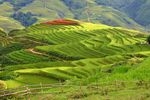|
 Dien
Bien is a northwestern mountainous province,
located about 500km from
Hanoi to the west. The natural area of the
province is 9554.097 square kilometers with
438.135 people. Dien Bien terrain is complex
composed of mountains stretching along the
Vietnam - Lao border with 100km long.
Interspersed with high mountains are valleys,
small, steep rivers and streams allocated across
the province. In particular, Muong Thanh valley
with flat surface formed a vast paddy field. Dien
Bien is a northwestern mountainous province,
located about 500km from
Hanoi to the west. The natural area of the
province is 9554.097 square kilometers with
438.135 people. Dien Bien terrain is complex
composed of mountains stretching along the
Vietnam - Lao border with 100km long.
Interspersed with high mountains are valleys,
small, steep rivers and streams allocated across
the province. In particular, Muong Thanh valley
with flat surface formed a vast paddy field.
Dien Bien has the tropical monsoon climate with
cold and dry winters and hot and wet summers.
The annual average temperature ranges from 21 to
23°C; the average rainfall is from 1700-2500mm;
the average humidity is 83 - 85%. Due to the
extensive natural area, dissected terrain, Dien
Bien climate is divided into 3 distinct
subregions including subregional climates of
Muong Nhe, Muong Lay and plateau climate
Son La and Ma River upstream.
Dien Bien is the ancient land. The province has
various ancient monuments including Tham Khuong
cave and Than Bua cave in Tuan Giao. In the 9th
- 10th centuries, Lu people in Muong Thanh were
the most developed in the area and controlled
Sin Ho, Muong Lay, Tuan Giao. Under the
French occupation of Vietnam, Hung Hoa was
divided into provinces of Hoa Binh, Son La, Lai
Chau, Lao Cai,
Yen Bai and some districts were merged into
Phu Tho.
Dien Bien is a province rich in tourism
potential, especially historical cultural
aspect. The most highlight is the historical
relics in the battle of Dien Bien Phu.
Historical relics of Dien Bien Phu victory is
the invaluable tourism resource, the gold mine
of Dien Bien tourism. Historical sites of Dien
Bien Phu consist of headquarters of Dien Bien
Phu - Muong Phang, Him Lam hill, Ban Keo hill,
Doc Lap hill and hills of A1, C1, D1, E1 and
command bunker of General De Castries. All are
gathered into a continuous relic cluster evoking
a vivid picture of the glorious historical
campaign of the nation.
Sights
Dien Bien Phu Museum
(admission 5000d; 7-11am & 1.30-5pm)
Commemorating the 1954 battle, this
well-laid-out museum features an eclectic
collection. Alongside weaponry and guns, there’s
a bath-tub that belonged to the French commander
Colonel de Castries, a bicycle capable of
carrying 330kg of ordnance, and photographs and
documents, some with English translations. At
the time of writing, a new modern structure to
house the collection was under construction.
Bunker of Colonel de Castries
(admission 5000d; 7-11am & 1.30-5pm) Across the
river the command bunker of Colonel Christian de
Castries has been re-created. A few discarded
tanks linger nearby, and you’ll probably see
Vietnamese tourists mounting the bunker and
waving the Vietnamese flag, re-enacting an
iconic photograph taken at the battle’s
conclusion.
A1 Hill
(admission 3000d; 7-11am & 1.30-5pm) There are
more tanks and a monument to Viet Minh
casualties on this former French position, known
to the French as Eliane and to the Vietnamese as
A1 Hill. The elaborate trenches at the heart of
the French defences have also been re-created.
Cemeteries
A formal French War Memorial , erected on the
30th anniversary of the 1954 battle,
commemorates the 3000 French troops buried under
the rice paddies. On the other bank of the Ron
River, the immaculately maintained Dien Bien Phu
Cemetery commemorates the Vietnamese dead, each
gravestone bearing the gold star of the
Vietnamese flag and a clutch of incense sticks.
Muong Thanh Bridge
The old Muong Thanh Bridge is preserved and
closed to four-wheeled traffic. Near the
southern end of the bridge – though not much
more than an overgrown crater – is the bunker
where Chief Artillery Commander Pirot committed
suicide. |
